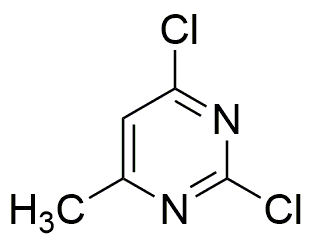2,4-Dichloro-6-methylpyrimidine is widely utilized in research focused on:
- Agricultural Chemistry: This compound serves as a key intermediate in the synthesis of herbicides, helping to control unwanted plant growth effectively. Its selective action minimizes damage to crops, making it valuable for sustainable farming practices.
- Pharmaceutical Development: It is used in the synthesis of various pharmaceuticals, particularly those targeting viral infections and cancer. Researchers appreciate its ability to enhance the efficacy of drug formulations.
- Material Science: The compound is employed in developing specialty polymers and coatings, offering improved durability and resistance to environmental factors, which is crucial for industrial applications.
- Analytical Chemistry: It acts as a reference standard in analytical methods, aiding in the detection and quantification of similar compounds in complex mixtures, which is essential for quality control in laboratories.
- Biochemistry: Researchers utilize it in studying enzyme inhibition and metabolic pathways, providing insights into biochemical processes that can lead to innovative therapeutic strategies.
Informations générales
Propriétés
Sécurité et réglementation
Applications
2,4-Dichloro-6-methylpyrimidine is widely utilized in research focused on:
- Agricultural Chemistry: This compound serves as a key intermediate in the synthesis of herbicides, helping to control unwanted plant growth effectively. Its selective action minimizes damage to crops, making it valuable for sustainable farming practices.
- Pharmaceutical Development: It is used in the synthesis of various pharmaceuticals, particularly those targeting viral infections and cancer. Researchers appreciate its ability to enhance the efficacy of drug formulations.
- Material Science: The compound is employed in developing specialty polymers and coatings, offering improved durability and resistance to environmental factors, which is crucial for industrial applications.
- Analytical Chemistry: It acts as a reference standard in analytical methods, aiding in the detection and quantification of similar compounds in complex mixtures, which is essential for quality control in laboratories.
- Biochemistry: Researchers utilize it in studying enzyme inhibition and metabolic pathways, providing insights into biochemical processes that can lead to innovative therapeutic strategies.
Documents
Fiches de données de sécurité (FDS)
La FDS fournit des informations de sécurité complètes sur la manipulation, le stockage et l’élimination du produit.
Spécifications du produit (PS)
Le PS fournit une description complète des propriétés du produit, notamment sa composition chimique, son état physique, sa pureté et les exigences de stockage. Il détaille également les plages de qualité acceptables et les applications prévues du produit.
Certificats d'analyse (COA)
Recherchez des certificats d'analyse (COA) en saisissant le numéro de lot du produit. Les numéros de lot et de lot se trouvent sur l'étiquette d'un produit, après les mots « Lot » ou « Lot de fabrication ».
Numéro de catalogue
Numéro de lot/série
Certificats d'origine (COO)
Ce certificat d'exploitation confirme le pays dans lequel le produit a été fabriqué, et détaille également les matériaux et composants utilisés et s'il est issu de sources naturelles, synthétiques ou autres sources spécifiques. Ce certificat peut être requis pour les douanes, le commerce et la conformité réglementaire.
Numéro de catalogue
Numéro de lot/série
Fiches de données de sécurité (FDS)
La FDS fournit des informations de sécurité complètes sur la manipulation, le stockage et l’élimination du produit.
DownloadSpécifications du produit (PS)
Le PS fournit une description complète des propriétés du produit, notamment sa composition chimique, son état physique, sa pureté et les exigences de stockage. Il détaille également les plages de qualité acceptables et les applications prévues du produit.
DownloadCertificats d'analyse (COA)
Recherchez des certificats d'analyse (COA) en saisissant le numéro de lot du produit. Les numéros de lot et de lot se trouvent sur l'étiquette d'un produit, après les mots « Lot » ou « Lot de fabrication ».
Numéro de catalogue
Numéro de lot/série
Certificats d'origine (COO)
Ce certificat d'exploitation confirme le pays dans lequel le produit a été fabriqué, et détaille également les matériaux et composants utilisés et s'il est issu de sources naturelles, synthétiques ou autres sources spécifiques. Ce certificat peut être requis pour les douanes, le commerce et la conformité réglementaire.


